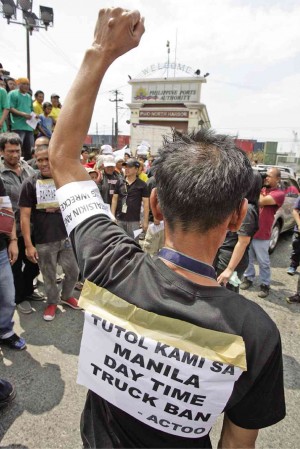
MEMBERS of trucking organizations, porters and other sectors gather in front of the Moriones gate of the Manila North Harbor Terminal on R10 in Tondo, Manila, on the first day of the implementation of an expanded truck ban in the city. NIÑO JESUS ORBETA
Following a dialogue with officials of the Manila City government, the Metropolitan Manila Development Authority (MMDA) and other government agencies, a truckers group on Monday agreed to give the expanded truck ban a try but under certain conditions.
Two other organizations, however, stood firm on their decision to go on strike indefinitely until Mayor Joseph Estrada and other officials back down from enforcing City Ordinance No. 8336.
On the first day of the city government’s implementation of the expanded truck ban Monday, traffic was light in the streets of Manila as truckers did not ply their routes as they had earlier threatened.
As early as 2 a.m., the city’s traffic police together with Vice Mayor Francisco “Isko” Domagoso stationed themselves on Roxas Boulevard to accost violators.
They were later joined by Estrada who had donned his camouflage uniform, the same outfit he wore in August when the city government implemented a ban on Manila-bound passenger buses without a franchise and terminals.
Estrada and the police went head to head with members of the Integrated North Harbor Truckers Association (INHTA) who had parked their trucks in front of the Moriones gate of the Manila North Harbor Terminal on R10 in Tondo to protest the expanded truck ban.
INHTA officers took the opportunity to explain why they were opposed to the new policy which bans eight-wheelers and vehicles with a gross weight of above 4,500 kilograms from plying the city’s streets between 5 a.m. and 9 p.m. According to them, the shorter hours would adversely affect their operations and the economy as well.
They also said that the concession offered by the Manila government—a window period between 10 a.m. and 3 p.m. which would be in effect for the next six to eight months—would not give them enough time to complete their deliveries.
A tug of war ensued when Estrada ordered the protesters’ trucks towed and some rallyists crawled under the vehicles to prevent these from being driven away. They were, however, dragged out by policemen as tow trucks took their vehicles away.
In a breakfast meeting with Estrada, Domagoso, MMDA Chair Francis Tolentino, Land Transportation Franchising and Regulatory Board Executive Director Roberto Cabrera III and Philippine Ports Authority officials at Aloha Hotel in Ermita, representatives of the trucker groups once again expressed their concern over the ban.
Rodolfo de Ocampo, chair of the Confederation of Truckers Association of the Philippines (CTAP) said that even with the window period, it would be hard for them to complete their operations especially with the “turnaround” time which usually takes about an hour or more.
CTAP chair emeritus and former national police chief Edgardo Aglipay also expressed concern that arriving goods would be stockpiled at the ports because of the shorter operating hours for truckers.
“Why don’t we give it first a try and when we encounter major problems, then we can meet again and consider other options?” Estrada told them, adding that the move was for the good of the majority, especially commuters.
In the end, CTAP, which claims to have 4,000 members, agreed to comply with the new truck ban but under the condition that a committee be formed to discuss the agreements made during the meeting. This included providing their members with holding areas for their vehicles so that they would not have to park their trucks on the roads before they enter the ports.
But hours after the consultation, around 100 members of the Alliance of Concerned Truck Owners and Organizations gathered at their office inside the Manila International Container Terminal to announce that they would continue to observe a truck holiday.
It will be up to the city government to act on their request that it go back to the old truck ban so that normal port operations could resume, they added.
Under the old system, trucks were banned in the city’s streets from 6 a.m. to 9 a.m. and between 3 p.m. and 9 p.m.